


Education doesn’t happen in a vacuum — and neither should its architecture. Children’s needs evolve, and the spaces they learn in must evolve too.
At ISA™, we believe educational design must reflect the unique developmental stages of its users. That means designing for toddlers, teenagers, and every stage in between — with insight, not assumption.
What a 2-year-old needs from a space is vastly different from a 12-year-old — and both are different again from a 17-year-old. Architecture must respond to these shifts.
Early childhood – Emphasis on tactile, low-scale, soft-edged environments that promote safety and exploration
Primary – Balance of stimulation and structure; clear routines supported by intuitive design
Secondary – Spaces for focus, independence, collaboration, and ownership of environment
A well-designed educational precinct supports the full journey from early learning through to adolescence. While spatial requirements shift, a cohesive architectural language can unify the entire experience.
Through materiality, wayfinding, and form, it’s possible to create age-appropriate spaces that still feel like part of a single educational identity.
These elements affect behaviour and cognition more than most people realise. We tailor them precisely based on age group:
Younger learners – Natural light, vibrant colour accents, lower sills, and warm materials
Older learners – Controlled lighting, calm palettes, more neutral environments to reduce sensory fatigue
The result? More focused learners, better wellbeing, and spaces that feel ‘just right’ for their users.
When students know where they’re going and what’s expected of them in a space, they feel more secure and act with more confidence.
Good architecture builds this into the layout. We use sightlines, materials, and clear zoning to support behaviour — not just to meet compliance.
Schools and early learning centres are long-term infrastructure. Too often, they’re designed only for the short term.
We build in flexibility and timelessness — not just to save money, but to support evolving pedagogy and growing communities.
With real-world constraints in mind, our team ensures that your project works on day one — and year ten.
Smart educational design means understanding the full spectrum of learning — from tactile play to academic focus.
At ISA™, we’re proud to bring deep user-first knowledge to every project. Because a space designed for learners grows with them — and that’s what great design is all about.